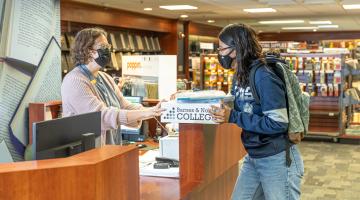
Explore consumer spending, key trends, historical data and NRF insights at our Back-to-School Headquarters.
Last week, NRF hosted a webinar with VP of Research Development and Industry Analysis Mark Mathews and Senior Director of Industry and Consumer Insights Katherine Cullen to discuss this year’s back-to-class shopping trends. Read more below for insights into how the current inflationary environment is shaping how elementary through college students and their families navigate the busy back-to-class season.
Spending is still going strong
Inflation is at the top of shoppers’ minds and budgets as they see higher prices not only on food and gas, but also back-to-class essentials like clothes and school supplies. The Consumer Price Index hit 9.1 percent last month, the highest in over 40 years, while the Producer Price Index was even higher at 11.3 percent. Despite these high inflation numbers, consumers are not pulling back on back-to-school and college spending. In fact, this year’s expected back-to-class spending is on par with last year’s record highs and exceeds pre-pandemic levels.
“Necessities are the most protected segment of retail,” Mathews said — and getting kids to school is essential for families. Consumers are cutting back on spending in other areas, working additional hours and taking other measures to cover costs for back-to-class shopping this season.
Electronics are here to stay
As Mathews noted, inflation alone does not account for this year’s back-to-class numbers, as robust spending has outpaced inflation rates in recent years. Traditional back-to-class categories such as computers, furniture and others have seen inflation ranging from 2 percent to 22 percent since 2019. Over the same time, total expected spending for back-to-school and college grew by 36 percent and 41 percent, respectively.
In the last three years, consumers have significantly shifted how they spend in certain back-to-class categories. Expected spending on electronics accounts for half of back-to-school growth and nearly one-quarter of back-to-college growth since 2019, solidifying its place as a core category in the back-to-class shopping season.
Addressing the significance of this year’s high expectations for electronics spending following strong growth since the onset of the pandemic, Cullen said, “It does tell us there is still a lot of stickiness in this category.”
Check out our back-to-school headquarters and learn more about consumer spending this academic year.
There’s more on the list
“People are really thinking about back-to-school and college the way they are other major spending events, like the winter holidays,” Cullen pointed out, as consumers begin preparing to go back to class sooner and sooner each year.
Fifty-six percent of back-to-class shoppers had started browsing and buying as of early July, up from last year’s 51 percent and considerably higher than 44 percent in 2019. Whether it be to stretch out their budget, plan for possible product delays or take advantage of deals and promotions, consumers are getting a head start on their shopping.
That said, the back-to-class shopping season is nowhere near over, with 88 percent still awaiting their school lists as of early July and 42 percent expecting to receive their lists by the end of the month.
For more insights into NRF’s back-to-class trends and a recording of the webinar, visit the Back-to-Class Landing page or view the webinar slides here.


